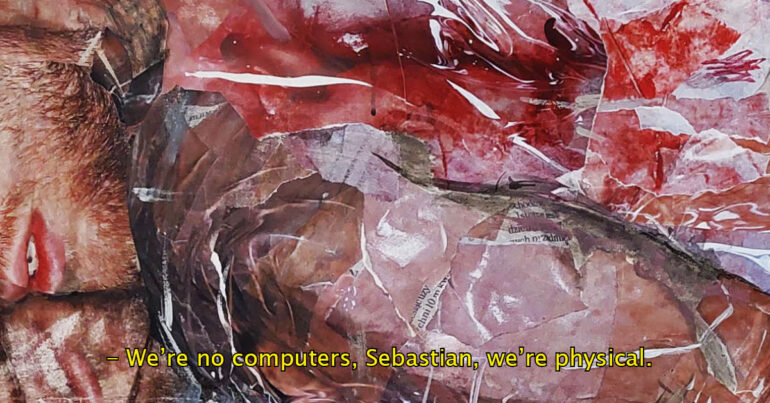

September 2, 2022
Opening day of the exhibition: September 2nd, 2022 from 6 pm
Duration: Sat. – Sun. (3/4.09) – from 4 – 9 pm
Guided tours:
3.09 at 17:00
4.09 at 17:00 with translation into PJM
The title of the exhibition is a quote from Ridley Scott’s ‘Blade Runner’. ‘There’s some of me in you. Show me something… like anything,’ says genetic engineer Sebastian to replicants Roy and Pris, whose DNA is partly of his design. Roy replies: ‘We’re no computers, Sebastian, we’re physical,’ thus refusing to follow orders.
The artist bears the same name as the engineer referenced in the title, and it is not a coincidence. It suggests that Winkler’s works resemble rebellious replicants and are lecturing their creator. As if emphasizing their own independence and their propensity for insubordination. As if saying: ‘We live in our own way. We are no machines ready to fight your battles or fulfil your sexual fantasies’ (in ‘Blade Runner’ these are the two tasks usually assigned to androids).
The works exhibited are all self-portraits – pictorial replicas or clones of the artist. They are queer failures of seeing, documenting unsuccessful attempts to build a solid identity out of visual scraps. They reflect a failure of socialization, society’s inability to force queer people into confines of heteronormativity. The artist’s pronounced interest in the domain of non-human – in figures of androids, aliens, clones, cyborgs, hybrids and Greek heroes – is a reaction to the experience of dehumanization,and also an expression of alienation, a queer estrangement from the status quo.
Most of these non-human characters have their eyes covered or closed. It reminds us of the saying that ‘eyes are windows to the soul’. In this case the windows are shut, and we cannot tell what – if anything – is behind. There are, however, two exceptions. Ellen Ripley is staring ahead, but not seeing – the dark, cracked eyeballs with no iris resemble black holes, as if they were sinking deep into themselves.They are both blunt and sad, mechanical and vulnerable at the same time. Zhora’s eyes are wide open, but (literally) lifeless, as she had been killed by the ‘blade runner’ allegedly representing the Committee of Moral Abuses. Actually, she was punished for an attempt to escape – for a refusal to conform and continue her work to the benefit of the oppressive system.
Most of the objects refer to the issue of work and reflect upon the problem of alienation, which results from it. There are motifs of physical, emotional and sexual labor, of labor as a life mission and as atonement. The only sculpture, which looks as if extracted from gay porn, is titled ‘The Floor Scraper’. It depicts something between a sex worker and a manual worker renovating a wooden floor – definitely a person totally unprepared to perform the assigned task, equipped with gay fetish accessories instead of professional construction tools.
This queer feeling of inadequacy is also manifested in a distorted vision. ‘I can feel it behind my eyes,’ confesses Ellen Ripley’s clone from Jean-Pierre Jeunet’s ‘Alien: Resurrection’, referring to the alien inscribed in her genetic code. Similarly, Winkler feels the alien nature of his desires, cultural codes, images and norms, which came from the outside (e.g. movies, commercials, pornography or myths), andare like implants put into his unconsciousness. And then plucked out and staged for display.
Written by Piotr Fortuna
Curator: Martyna Stołpiec
Cooperation: Milena Stryjewska
UA
Відкриття виставки: 2 вересня 2022 р. с 18:00
Тривалість: сб.–нд. (3 / 4.09) – від 16 – 21
Екскурсії:3.09 о 17:00
4.09 o 17:00 з перекладом на PJM
Себастьян Вінклер | МИ НЕ КОМП’ЮТЕРИ, СЕБАСТЬЯНЕ, МИ ЖИВІ
Назву виставки взято з фільму «Той, хто біжить по лезу»Рідлі Скотта. «У вас є щось від мене. Покажіть мені щось… що завгодно», — каже генний інженер Себастьян до Роя та Пріс, двом реплікантам,ДНК яких він створив. Рой відповідає: «Ми не комп’ютери, Себастьяне, ми живі». І тому відмовляється виконувати інструкції.
Схожість імен між митцемта кінорежисером не випадкова. Це припущення, що твори Вінклера виховують свого творця, як бунтівних реплікантів. Вони ніби хотіли підкреслити власну незалежність і схильність до непокори. Ніби вони кажуть: «Ми живемо своїм життям. Ми не машини для боротьби або здійснення сексуальних фантазій»(у фільмі Скотта для цих цілей найчастіше використовувалися андроїди).
Представлені на виставці роботи – це автопортрети – візуальні репліки/клони художника. Це квірові помилки бачення, записи невдалих спроб склеїти ідентичність із уривків зображень. Вони відображають невдачу соціалізації, що примушує квір-людей до гетеронорми. Виразний інтерес художника до нелюдського – фігур андроїдів, інопланетян, клонів, кіборгів, гібридів, міфічних героїв – є реакцією на досвід дегуманізації, а також проявом ізоляції, відчуженості від статус-кво.
У більшості цих нелюдських персонажів очі прикриті або закриті, що нагадує вислів «очі як вікно душі». Що ж, в даному випадку вікна зачинені, і важко зрозуміти, чи є за ними взагалі щось. З цього правила є два винятки. «Еллен Ріплі» дивиться, але не бачить — її темні, потріскані, позбавлені райдужної оболонки, очні яблука схожі на чорні діри, вони ніби все глибше занурилися в себе. Вони здаютьсятупими й сумними, механічними й вразливими водночас. У Жори ж очі широко розплющені, але мертві. Її вбив мисливець, видаючи себе за представника Комітету Моральних Злочинів. Це було покарання за спробу втечі, за відмову підкорятися і вести подальшу роботу на користь репресивної системи.
Решта об’єктів також відносяться до категорії праці та пов’язаного з нею відчуження. Є прояви фізичної, емоційної та сексуальної роботи, роботи як місії і як покаяння. Єдина скульптура, ніби взята з гей-порно, називається «Циклініар». На ньому зображено чи то секс-працівницю, чи то робітника, який намагається відремонтувати паркет – так чи інакше фігуру, абсолютно не готову до покладеного на неї завдання, з фетишними аксесуарами замість інструментів для ремонту та будівництва.
Ненормативність і викликане цим почуття неадекватності проявляється в порушеннях зору.
«Я відчуваю це за своїми очима», — зізнається клон Елен Ріплі з «Чужий: Воскресіння» Жана-П’єра Жене, маючи на увазі прибульця, з яким у нього спільний генетичний код. Так само Вінклер відчуває відчуженість своїх бажань, культурних кодів, образів, які прийшли ззовні (фільми, реклама, порнографія, міфи) і були прищеплені в його несвідомому, як імпланти. А потім вирвані і виставлені на огляд.
Автор тексту: Пьотр Фортуна
Куратор: Мартина Столпєц
Співпраця: Мілена Стриєвська